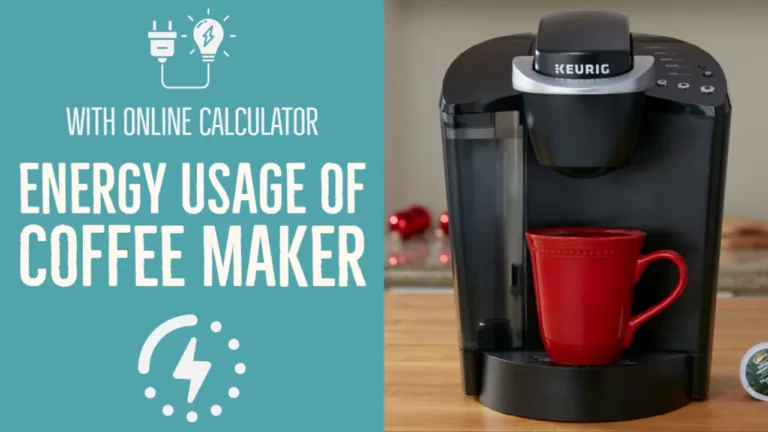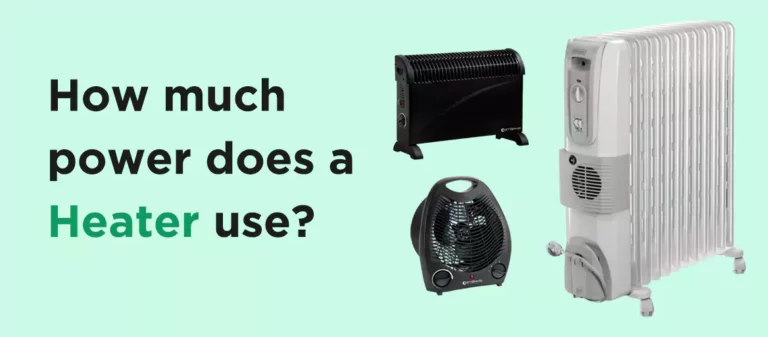Power Consumption of Automatic Washing Machine (Calculator both Top & Front Load Machine)
Automatic machines are of two types, i.e., either semi-automatic or fully automatic. As the names suggest, the first one requires you to do “some” stuff on your own while the second one performs all the tasks involved on its own. This “some” stuff refers to changing “the tubs” a semi-automatic washing machine has one for washing and one for drying the clothes.
On the other hand, a fully automatic machine– along with managing all of its washing and drying in a single tub, controls almost everything, including even the time and the washing intensity for the fabric on its own; you literally are to press a button only! Performing all of its tasks on its own makes it a bit more time-consuming, which is understood.
Well, automation comes for a cost, right? The more smartness you want from a system, the more you have to invest in it. Also, a fully automatic machine provides you with a number of modes for washing and better quality washing results for any kind of cloth. All these advantages make a fully-automatic machine more expensive as compared to a semi-automatic one.
In this article, we are going to show you how you can calculate the power an automatic washing machine consumes by yourself, which will help you make better choices about your future purchasing of a washing machine, and then we will go through some useful tips that will reduce the amount of power your machine consumes. So let’s dive right into it!
Power Consumption Calculator:
You can use a power consumption calculator to estimate how much power your washing Machine is using. You can use this to determine if you’re washing using too much power.
How to calculate the power consumption of a Automatic washing machine
The first thing you need to know about power consumption is that the calculation of power consumption for any electrical appliance or machine is given by a single formula. Power consumption is calculated in the units of “kiloWatt hour (kWh).” kWh is the unit of electricity in which we get our electricity bills.
This can be obtained by determining the number of hours a machine is used in a day and the “Rated power or Wattage” of the machine. The wattage of a machine is given by its manufacturer on its label and datasheet, and it is the amount of power in Watts.
Following the unitary method, you only need to take the product of the total hours the machine has been used and the wattage of that machine. To put all this in the form of an equation, we have a power consumption formula for washing machine, giving the power consumption in the units of a kiloWatt hour (kWh):
Power consumption (kWh) = (Wattage of the machine X Operating hours a day)/1000
(Note: Do not write the wattage of the machine in kiloWatts, keep it in Watts in the above formula)
This formula gives the power consumption by the machine in a day. But you might be more interested in finding the power it consumes in a month as it concerns our monthly electricity bills, right? Power consumption in a month can be calculated by simply multiplying it by the number of days in that particular month.
Similarly, a yearly estimate can be made by multiplying the above kWh by 365 days.
The usage of a washing machine in a day might be less than an hour, depending upon the population of clothes washed. If the machine is operated for less than an hour or for a few minutes, you will have to introduce this into the formula by replacing hours with the minutes the machine was used divided by 60 minutes (which gives the portion of an hour the machine was used, e.g., ½ hour or ¾ hour, etc.).
Power consumption (kWh) = Wattage X (Operating minutes / 60 minutes) /1000 = Wattage X Operating minutes / 60,000
Types of Fully Automatic Washing Machine
A fully automatic machine is either “Top load” or “Front load.” A general perception about the two is that the only difference between them is that in the front load, you have to place the clothes into the tub from the front lid, while in the top load, this lid is on the top, which is not correct!
Both the machines have their own mechanism and thus are different with reference to the power consumption.
Top Load Machine Fully Automatic
A top Load fully automatic machine is cheaper than the front load washing machine, but it has a lower RPM (Revolutions per minute) which results in lower power consumption. The maximum power required for a Top Load Machine Fully Automatic is 350 – 1200 watts.
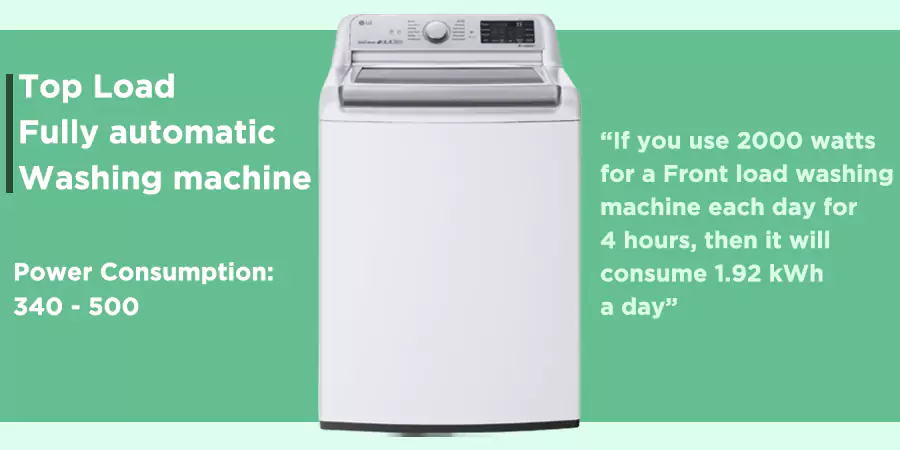
It uses double the amount of water a front loader uses. And if it has a heating mechanism, it will take longer to heat that large amount of water and thus consumes overall more power.
Front Load Machine Fully Automatic
Front-load washing machines are expensive due to the quality of wash it provides. But it is only a one-time investment because its power consumption is lower than a top load washing machine.
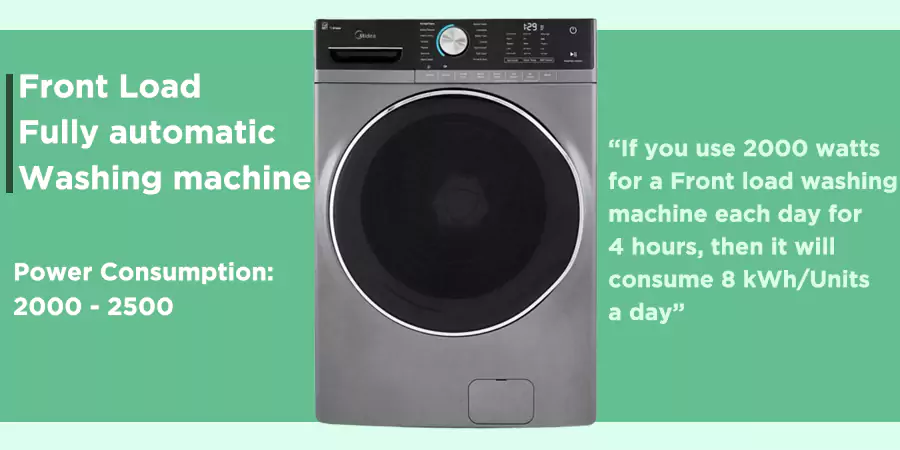
Front-load washing machines provide a greater number of features and are environment friendly as they make very little vibrations and noise. A front load machine fully automatic requires between 1850 and 2500 watts. The power consumed by an average Front-load machine can be calculated by the formula previously discussed.
How much power does a washing machine use?
It might seem like automation consumes a major part of the energy, but it is not true because the tiny valves in the machine and such digital control equipment take only a negligible amount of energy as compared to other functions. The two main reasons for the power consumption in a washing machine are the motor which rotates the washer and the heating equipment for the water. The heating process of water consumes most of the power.
If we talk about an average washing machine, it has a rated power of around 350 to 2500 Watts. But if it is an automatic washing machine operated with the option of hot water, its rated power will be around 2000 and above. Resulting in 0.5 kWh and 2.5 kWh of power consumption (electricity units) a day, respectively, if operated for an hour.
Also, we do not usually use our washing machines every day, and it is just over the weekends that we find time for laundry. If the washing machine is used for 4 hours, its average usage per day comes out to be 0.57 hours.
Power Saving Tips For Washing Machine
Appliances are guaranteed for a time period only when they are used according to the manual. Careless use of any machine reduces the life and efficiency of the machine. Although these automatic machines are expensive and consume more electricity, you can save this electricity by operating the appliances in the right manner. Below are some of such tips that can help to cut off your electric bills:
- The first and most useful advice is to update to more efficient washing machines. The latest machines consume almost half of the electricity as their old counterparts. Top-notch washing machines have features like eco-mode and speed-wash that save electricity and time without compromising the quality of washing.
- Reducing the number of washing cycles is another tip that can save a lot of energy as the washer will use almost the same amount of energy whether you wash a few shirts or load the drum completely. So, to get the most out of your machine, it is better to wait until you have collected enough clothes to load the machine completely; this will reduce energy consumption. Pre-soaking clothes in water and using some stain remover can also help.
- Using detergents designed for automatic machines can help save electricity by reducing the machine load. Detergents on the market are particularly designed for automatic washing machines; unlike other detergents, they do not make too much lather, so the machine does not have to wash again and again, consuming more water and electricity.
- Turning off the hot water function can reduce electricity consumption. Some machines have this feature enabled by default, and they heat the water before cleaning. However, for regular washing, you don’t always require hot water. Using cold water and turning off the hot water function can save a ton of electricity.
- Another way to save energy is to adjust the dryer’s timing. As dryers consume a lot of energy, it is better to dry your clothes under the sun if you have time and a few hours of sunlight.
- Unplugging electric appliances when not in use is the often heard tip to save energy.
A good point of Front load washing machines
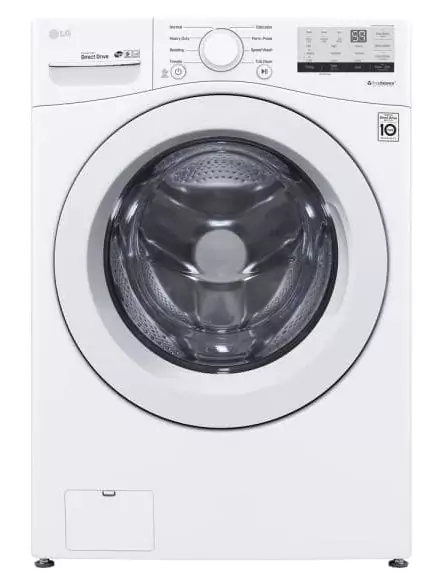
- It is more water and energy efficient.
- Front-loaders remove more dirt and grind and are better at removing stains in almost all tests.
- Front-loaders spin 33% faster than top loaders, removing more water out of clothes so they dry fast in the dryer.
- The installation is easier and more flexible as the dryer can be stacked on the washing machine.
- They are quieter.
A good point of Top load washing machines

- More convenient to use, especially for older people, as they do not require the user to bend over.
- They require less maintenance.
- Top load washers typically wash clothes faster since they immerse them in water for the whole wash cycle.
- You can add more clothes mid-cycle.
- No issue of odor, mildew, or mold.
Use watt Meter to Calculate Power consumption:
Watt meters measure the power consumption of any electrical device. They can be used to diagnose problems with devices that consume large amounts of power.
List of Fully Automatic Washing Machines Wattage :
| Washing Machine Name | Power |
|---|---|
| LG Front Load Washer – WM3400CW | 1200 Max Watts |
| Samsung Front Load Washer – WF45T6000AW | 1800 Max Watts |
| GE Front Load Washer – GFW550SSNWW | 2400 Max Watts |
| Electrolux Front Load Washer – ELFW7637AT | 1800 Max Watts |
| Hotpoint Top Load Washer – HTW240ASKWS | 1200 Max Watts |
| GE Top Load Washer – GTW465ASNWW | 1200 Max Watts |
| Maytag Top Load Washing Machine – MVWC565FW | 2400 Max Watts |
Final Words:
There is a whole range of front load or top load automatic washing machine models available in the market, providing different features. Among them, you have to select the one that consumes the least power but does most of your work efficiently. It is all about a cost-benefit analysis!
Although washing machines do not consume much power in a month and thus do not contribute to the increased electricity bills, still careful and intelligent use of washing machines can further help you save some bucks on your electricity bill.
FAQs:
How powerful are washing machine motors?
What wattage does a washing machine use?
Will a car battery power a washing machine?
Can a small tiger generator power the washing machine?
References:

